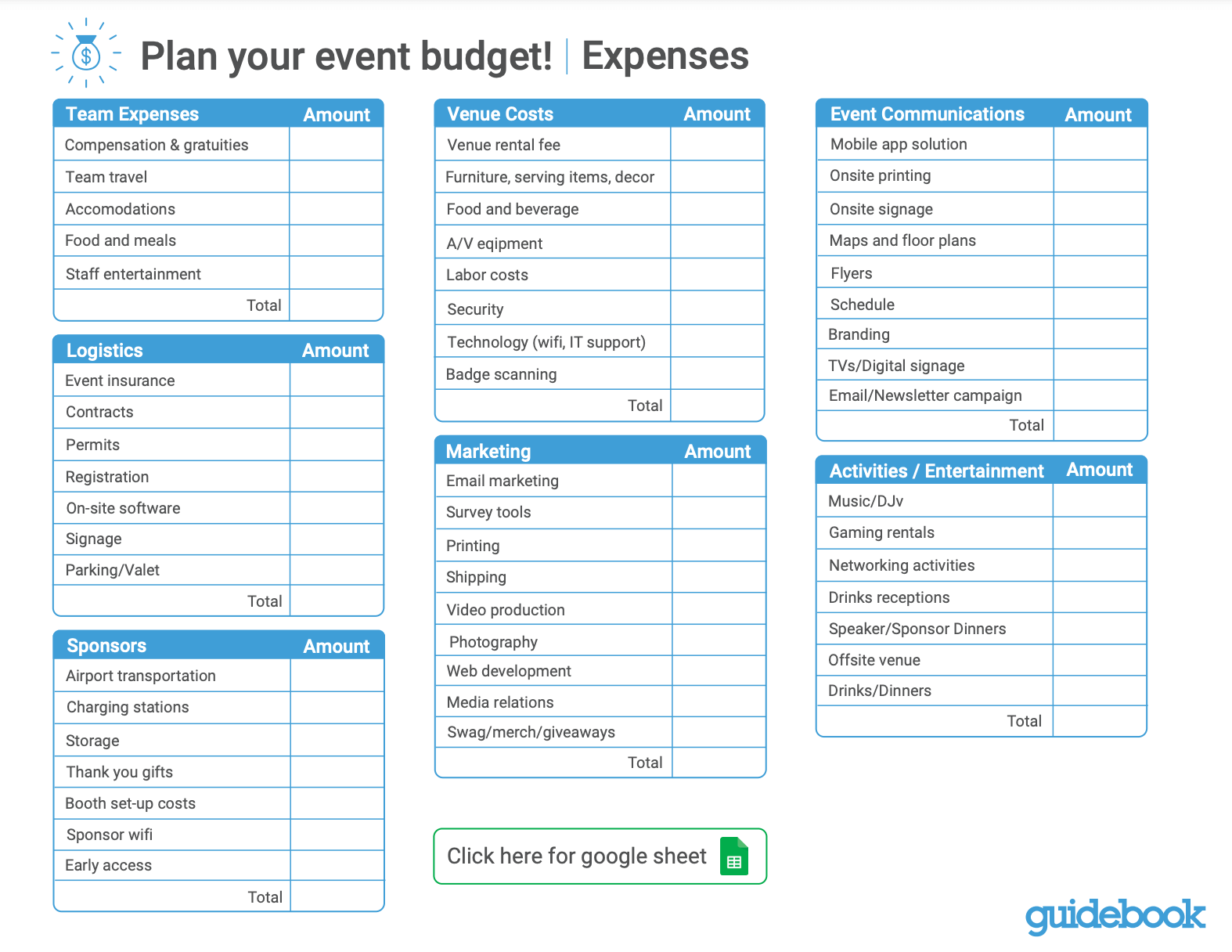Step-by-Step Guide to Creating an Event Budget
Creating an event budget can be overwhelming! With a laundry list of expenses, it can be tempting to skip the planning and jump right into signing contracts with your vendors. Though this may sound like the easy route – without a clear budget, you’re setting yourself up to blow it.
In this guide, we’ll show you how approaching your budget in phases can take some of the initial pressure off yourself, and help you build a strong budget in stages. Let’s take a look at the 4 stages – simplifying budgeting from start through post-event!
Stage 1: Identify your event budget strategy
Before you jump into creating your event budget, it’s important to first dedicate time to lay the foundation for your event. To do this, you should take these steps:

Determine the type of event and overall event budget
Start with the basics, you should clearly identify the type of event you’re planning and the overall budget for the event. It is always best to begin designing an event around your available resources and not vice versa.
Are you hosting a cocktail reception with $10,000 to spend? A user conference with a $200,000 budget? A team meeting with a $2,000 budget? Whatever the event is, the first step is identifying what you have available to spend.
This overall budget may come down from a manager, a finance department, or from the own budget you manage. While processes for identifying a budget vary – the importance of this step is true.
Evaluate past events
Your past events can provide you with a wealth of data and information on creating a budget for your next event. Evaluate your past events to understand the areas you over or underspent on. Did you go way over on printing costs? You may want to adjust your budget or consider new vendors.
For example, if after evaluating your previous event, you realize you overspent on food, you can go into your high-level plan with a better understanding of how you’ll need to adjust your budget.
Research to understand the industry
Do some research to find common trends, for example, if you overspent on your expected AV costs, research the going rate within the industry. You may walk away with insights like, the going industry rate is lower than what I paid or I under-budgeted and need to up my AV budget.
It’s impossible to be an expert and know the costs of every vendor, but by researching early on, you’ll go into planning with a clearer picture of industry-standard costs.
Create a high-level plan
Your high-level event plan should outline your event goals and basic logistics. Additionally, once you start mapping out your logistics, you can begin to include rough budget estimates. You can begin by listing out the items that are must-haves, like a venue or catering.
We’ll get you started with typical high-level spending categories:
- Venue
- Speakers
- Staffing
- Signage and branding
- Food and Beverage
- Attendee Experience
- Marketing
- Event technology
- Transportation
- Furniture and equipment
As you identify your high-level must-haves, begin to estimate the expenses for each. While building your event program with these high-level items and estimates, you will have a better projection of the total expenses.
Get buy-in from stakeholders
Now it’s time to share the projected budget with your stakeholders. This is important to make sure they are aware of the budget, agree and approve of it, and keep themselves accountable. The earlier you’re able to communicate your high-level plan, the better – so there is no confusion or surprises down the line.
Learn how event app sponsorships can help you earn money during your event.
Stage 2: Estimate Your Costs
With your high-level plan and budget in place, you can begin mapping out your individual line items. Get your list started with the items you know you’ll need – venue, food and beverage, and marketing, for example.

Map out individual line items and lock in vendors
Once you have your high-level items, it’s time to get down to the nitty-gritty items. As much as you may want to lump categories of expenses together, the more detailed you are, the more organized, and accurate your budget will be.
Drilling down into line items
Here, you’ll want to take a look at all of your high-level expenses and break them down further, for example, start with a high-level category, and list the line items:
Marketing
- Social media
- Online Ads
- Email marketing
- Photography
- Design agency
- Event materials
Here’s another example:
Venue
- Location rental
- Equipment rental
- WiFi
- Venue-specific staff
- Security
Firm up your projected costs
As you build out your detailed list of line items, continue reaching out to vendors for quotes. Taking this approach enables you to work through your list of vendors over a longer period, rather than doing all of your vendor outreach at once – right before your final budget is due.
Your projected line item costs should be reflected in vendor proposals and quotes. At this point, you should be identifying the right vendors for each area of your budget and entering into formal agreements and contracts for the event.
Tip: If you’re new to events, take time to build relationships with your vendors. These relationships can help you ensure you’re working with the right vendors for your events. That’s why it’s wise to do research early on, so you can find people and businesses who match your needs and goals.
Want a little help creating a budget? Download our Event Budgeting Template to get started.
Complete list of line items
At the end of this stage, you will have built out a complete list of your expected line items.
The FREE Event Budget Template from Guidebook
Here’s our free Event Budget Template to help you get started. Download the PDF as a guide, and make a copy of our Google sheet today! Our clients love the formulas built into the Google sheet.
By the way, it’s possible to earn revenue at your event through Event App Sponsorships. When you build your event app with Guidebook, you get access to incredible sponsorship capabilities. Get the Ulitmate Guide to Increase Sponsorship Revenue with an Event App to learn more and see real examples of how others earned money with their Guidebook apps.
Free Event App Sponsorship Ebook
Stage 3: Finalize your event budget
As you make important decisions like choosing your vendors, location, and service providers – you are piecing together a final budget. At this point, you’ve signed many of your contracts and are beginning to pay your vendors. The next step is to actualize your budget and ensure you’re staying in the green.

Time for an actual costs column!
Add a column to your spreadsheet labeled “Actual Spend.” As you finalize and sign contracts with your vendors, begin to track your actual spend against your projected spend.
Even if your actual spend doesn’t match up perfectly with your projected spend, it’s helpful to see these numbers side by side. As you start to fill in your actual costs, you’ll have complete visibility into how your line items are adding up against your total budget.
Remember, events can be unpredictable
Once you’ve firmed up your budget, add one more line item – a contingency fund. Depending on the size or complexity of an event, you may want to give yourself as much as up to 20% of the event budget here.
Despite meticulous planning, there is always the possibility of changes to your budget. A contingency fund ensures you’re prepared to handle any changes or additional expenses that may cause you to exceed projected plans. This will keep you from going over budget every time.
It’s important to also get your stakeholders’ sign-off on your contingency fund. Even if it is an emergency fund, should you need to dip into it, you want the team to be aware and prepared. Give yourself wiggle room with a contingency fund to reduce some of the stress that comes with dealing with multiple moving pieces.
Learn how event app sponsorships can help you earn money during your event.
Stage 4: Post-event settling and evaluation
If you have been diligently tracking your spending – this piece should be a breeze. After your event has concluded, you’ll want to revisit your budget and contracts to ensure you’re settled on all financial obligations.
You should also ensure every single cost is reflected in your budget. Once you have a comprehensive view, you can turn those numbers into insights.

Evaluate your event budget and spend
After all of your costs are finalized and payments are made, revisit your budget for final numbers.
Identify your total spend
What was the total damage? Whether you are using Budgeting software that will total up your line items for you or are going in with a spreadsheet, pull together your final and total amount spent.
You’ll need to share that number with your stakeholders and it will be helpful in measuring outcomes from your event.
Pull out insights from your budget
Identify savings
If you had any major savings, highlight those savings in your actual budget vs. the projected budget. Calling your savings out will help you tighten up future budgets. Calling this out will also go to demonstrate the value you brought to the role – go you!
Identify overages
Conversely, if there were areas where you went over your budget, make a note. You may want to investigate the reason. It could be because you under-budgeted for a given line item, incurred additional expenses with the vendor, or maybe the overage was within your padded expectations.
Identifying these outlying figures will provide insight for you and your stakeholder. Additionally, analyzing your budget immediately following your event will make it easier for you to plan and make adjustments for future events.
Conclusion
Because planning an event can be overwhelming, it’s important to get ahead of your budget early. Working in stages, like the ones outlined in this guide, help to make creating and staying on top of your budget more manageable.
We hope these tips are helpful in getting started in creating a comprehensive event budget. Remember, it’s key to track every expense for each one of your events to help you stay on budget.



